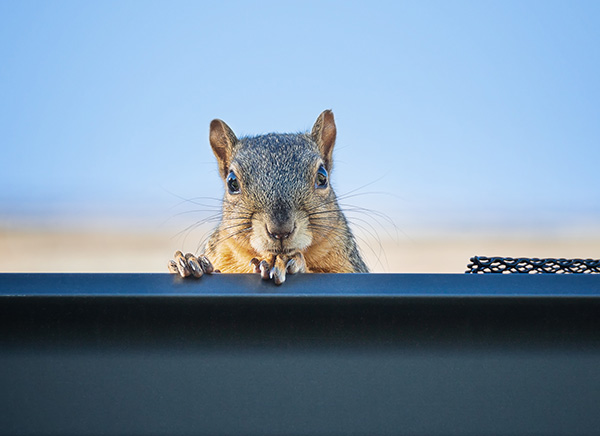Preventing Animal and Squirrel Damage in Commercial Roofing
Author: Lee Polevoi | August 7, 2024
Preventing animal damage to a commercial rooftop should be at the top of every business owner and roofing contractor's to-do list. Problems arising from squirrel damage (as well as damage from other urban critters) can significantly impact a rooftop's integrity, not to mention causing unsightly wear and tear that, to walk-in customers, may convey an image of disuse and lack of proper maintenance.

In general, the same "pests" that plague homeowners' structures also prey on commercial rooftops. Squirrel damage is just one obvious challenge. Other animals, ranging from rats, raccoons and wasps to bats, pigeons, crows and sparrows, should also be discouraged from wreaking havoc on commercial rooftops.
Animals in search of food and shelter can leave scratches and other damage on shingles, gutters and roofing materials as a whole. Additionally, acidic bird droppings work to corrode a roof over time, while squirrels and raccoons often gnaw through wood and asphalt materials.
Here, we'll discuss how contractors can address these commercial customer concerns.
Recommend Twice-Yearly Inspections
In your role as a trusted partner in a commercial roof's ongoing integrity, it's vital to emphasize the value of regularly scheduled maintenance and inspection. Customers rely on you to be proactive in terms of identifying animal damage and other indicators of a creature's unwanted presence on their roofs.
The general consensus among roofing contractors is to conduct inspections of a commercial rooftop at least twice a year. This greatly increases the odds of spotting a small problem and keeping it from increasing in magnitude, thereby costing the customer more time and money than necessary.
Be sure to make these biannual inspections as thorough as possible. Look for cracks or holes caused by roving animals, as well as damage to eaves, soffits, gable vents and the edges of the roof. What are you looking for? Telltale signs of an animal's presence range from urine and droppings to tracks, nests and indications of gnawing on roofing materials.
It's up to you to outline these adverse situations to commercial customers, so they understand the value of these inspections.
Emphasize Prevention
The best strategy when contending with animal damage is prevention. These two key steps can help keep animals away from a structure's rooftop and forestall more expensive damage repair at a later date:
- Eliminate access to the roof. As with homeowner structures, animals can access commercial rooftops from neighboring trees and other foliage. Advise customers to instruct their landscaping crews to trim overhanging branches.
- Keep animal-attracting factors at bay. Commercial customers should take special care to maintain a physical distance between their building and trash cans, bird feeders, sources of water and any other element that might draw a creature's interest. Motion-sensitive sprinklers also deter squirrels from investigating flowers, gardens or other potential food sources.
By reducing or eliminating access, contractors can help ensure that commercial rooftops are far less likely to be plagued by animal damage.
Protective Measures Roofers Can Take
Another key factor for avoiding animal damage to commercial roofs is taking protective measures.
- Create obstacles for entry. Most potential "entry points" for animals (chimneys, roof vents, etc.) can be blocked using metal flashing. Flashing materials like aluminum and galvanized steel are durable enough to both protect against weather concerns and keep animals at bay. Wire mesh and other protective screens are useful alternatives.
- Opt for roof guards. Roof and gutter guards are another effective barrier against animal damage. Gutter guards in particular are helpful in keeping gutters free of animal waste or other unwanted leavings.
- Repair and reseal shingles. Cracked or weather-impaired shingles offer tantalizing access to squirrels, rats and other creatures. Advise customers of the need to immediately repair and reseal broken shingles to prevent unwanted entry.
Another effective strategy is deterring birds, squirrels and other animals from approaching a commercial rooftop in the first place. Commercial business owners might consider the use of:
- Noise-making devices and blinking lights
- Chemical repellents
- Fencing around the commercial property
- Meshwork and bird spikes
While these cautionary steps may not fall under the category of roofing contractor responsibilities, your customers will appreciate all the helpful advice you can give them.
Finally, if animal damage is a concern among customers, you can recommend roofing materials known for both durability and utility as barriers to entry. These materials include slate tiles, metal roofing and concrete tiles — offering no way for creatures to gain entry and make nests on the roof. At the same time, these materials can provide attractive curb appeal, another useful element for businesses and their customers.
Roofing contractors who help prevent animal-related damage to rooftops are likely to inspire greater loyalty among their commercial customers.